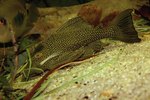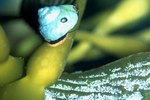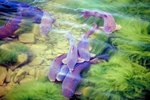If you maintain an aquarium, it's important that your tank contain adequate amounts of plankton to feed the inhabitants. Not all the inhabitants eat plankton directly -- in fact, most don't -- but they are a crucial part of the food chain for freshwater, marine and reef tanks.
Zooplankton and Phytoplankton
In the surface waters of the ocean, minute drifters known as zooplankton -- who are animals -- eat minute drifting plants, known as phytoplankton. The latter are also known as algae. Both are at the bottom of the food chain, but they're an essential part of it. If you've heard aquarists use the term "green water," regarding feeding, they are referring to phytoplankton. Hobbyists who breed fish provide the newly hatched fry with phytoplankton for their earliest meals. While fry from live-bearing fish usually can eat commercial fish foods as soon as they leave the mother's body, that's not the case with many common hatched fish. Fry that benefit from initial phytoplankton meals include:
- Tetras
- Gouramies
- Rainbow fish
- Gobies.
Zooplankton is also a good source of nutrition for fry.
Feeding Anemones
Various anemone species from temperate waters consume plankton. In nature, these colorful creatures consume specific types of fish, larva, bivalves, invertebrates and other sea dwellers, but species that prefer one type of food also may eat plankton.
The Algae Eaters
Phytoplankton are too small to be seen with the naked eye. However, you can certainly spot algae accumulation in your tank. Bottom-dwelling algae eaters help keep the tank clean. The best choices include various types of catfish:
- Whiptails, also known as lizard catfish
- Twigs, also known as stick catfish, for their flat shape
- Pygmy suckermouths
- Clown pleco.
Other good algae eating choices include:
- Siamese algae eater
- Florida flagfish
- Stone lapping fish
- Flying fox, one of the most attractive of the generally plain algae eaters.
Tips
Not everything labeled an algae eater in the pet store is particularly good at the job. Avoid the Chinese algae eater. He not only doesn't eat much algae, he can end up killing off every other fish in your tank.
Snails, Shrimp and Clams
Although this trio sounds like the featured dish at a seafood restaurant, snails, shrimp and clams are efficient algae/plankton eaters. The best types for algae consumption include:
- Snails: the pond snail and the ramshorn snail. Both remain relatively small. If you desire a large snail in the tank, consider the mystery snail.
- Shrimp: The Amano shrimp not only does a great job of eating algae, he's also quite an attractive addition to the tank. You can purchase ghost shrimp cheaply, as they are primarily sold for feeding bigger fish. That is one downside of keeping shrimp for algae eating -- other tank mates enjoy a shrimp dinner.
- Clams: Freshwater clams are among the best algae consumers. They don't add anything to tank beauty because they dig themselves into the substrate and you never see them.
Writer Bio
Jane Meggitt has been a writer for more than 20 years. In addition to reporting for a major newspaper chain, she has been published in "Horse News," "Suburban Classic," "Hoof Beats," "Equine Journal" and other publications. She has a Bachelor of Arts in English from New York University and an Associate of Arts from the American Academy of Dramatics Arts, New York City.





